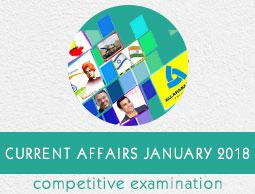Current Affairs January 2018 - Technology
1 - PSLV successfully launched 31 satellites in a single flight

ISRO’s Polar Satellite Launch Vehicle, in its forty second flight, successfully launched the 710 kg Cartosat-2 Series Remote Sensing Satellite along with 30 co-passenger satellites from Satish Dhawan Space Centre SHAR, Sriharikota. This flight is designated as PSLV-C40.
The 28 international customer satellites belong to Canada, Finland, France, Republic of Korea, UK and the USA. So far, PSLV has successfully launched 51 Indian satellites and 237 customer satellites from abroad.
2 - India, US working together to develop vaccines

According to Washington's envoy to New Delhi Kenneth Juster, India and the United States are working together to develop vaccines against diseases such as tuberculosis and dengue. India and US jointly developed the first indigenous Indian vaccine for rotavirus.
The two nations were also engaged in the Global Health Security Agenda, which included acting to combat anti-microbial resistance and strengthening the detection and prevention of epidemics.
3 - India’s fastest and first multi-petaflops supercomputer dedicated to nation

Union Minister Harsh Vardhan dedicated India’s fastest and first multi-petaflops supercomputer to the nation.
The supercomputer named as ‘Pratyush’ meaning the Sun, established at the Indian Institute of Tropical Meteorology (IITM), Pune, will be a national facility for improving weather and climate forecasts and services under the umbrella of the Ministry of Earth Sciences (MoES), Govt. of India. Petaflops is a measure of a computer's processing speed.
4 - ISRO released first image taken by Cartosat-2 series satellite

ISRO released the first image captured by its Cartosat-2 series satellite. Cartosat-2 Series satellite was successfully launched onboard the PSLV-C40 rocket by ISRO.
The image shows a part of Indore city in Madhya Pradesh with the Holkar Cricket Stadium in the centre. Cartosat-2 is an advanced remote sensing satellite similar in configuration to earlier six spacecraft in the series and intended to augment data services to the users.
5 - Germany scientists developed ultra-thin electronic skin tattoos

Scientists in Germany have developed ultra-thin electronic skin tattoos that can help control virtual and physical objects with mere hand gestures. The polymer foil having sensors is extremely thin and almost invisible. It sticks to the palm of the hand like a second skin.
These sensors will enable people to manipulate everyday objects. It will also help control appliances both in the physical world and in augmented or virtual reality with mere gestures similar to how we use a smartphone now.
6 - 2 NASA astronauts successfully conduct first spacewalk of year

Two NASA astronauts have successfully conducted the first spacewalk of the year, replacing a degraded robotic "hand" outside the International Space Station (ISS). Expedition 54 flight engineers Mark Vande Hei and Scott Tingle spent seven hours and 24 minutes working outside the orbiting laboratory.
Their primary task was to swap out one of the two "hands" on the Canadarm2 robotic arm. The event marked the 206th spacewalk conducted by ISS astronauts in support of the station's assembly and maintenance.
7 - Scientists discover Gen-next smart solar windows

Scientists at the Lawrence Berkeley National Laboratory (Berkeley Lab) in the US have have discovered a new material for next-generation smart windows. The maaterial is a form of perovskite that not only helps darken automatically when the Sun is too bright but also convert solar energy into electricity.
The photovoltaic glass is reversibly thermochromic and can prove to be a revolution in green technology. The team of researchers was led by Peidong Yang.
8 - Chinese scientists cloned monkeys for first time successfully

Scientists at the Institute of Neuroscience in Shanghai, China have successfuly cloned monkeys using the same technique used to clone Dolly the sheep. The two identical ong-tailed macaques named Zhong Zhong and Hua Hua are the first primates to be cloned from a non-embryonic cell.
The DNA from which Zhongzhong and Huahua were cloned came from fetal fibroblasts, a type of cell in connective tissue. Cloned and genetically modified monkeys could be very useful for studies of some diseases.
9 - First India-designed vaccine to pass WHO test

The World Health Organisation has approved a vaccine conceived and developed in India to be “pre-qualified”. The Rotavac vaccine was developed by the Hyderabad-based Bharat Biotech Limited. To be “pre-qualified” means that the vaccine can be sold internationally to several countries in Africa and South America.
The vaccine was included in India’s national immunisation programme and it protects against childhood diarrhoea caused by the rotavirus. Rotavirus is responsible for an estimated 36% of hospitalisations for childhood diarrhoea around the world.











